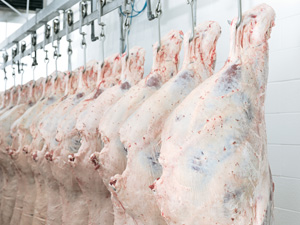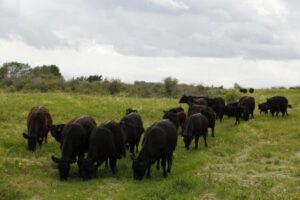Carcass Data Important for Seedstock Development Research
Remarque : cette page web n’est actuellement disponible qu’en anglais.
Access to carcass data as well as other production information through the Beef InfoXchange System (BIXS) will be an invaluable tool for cattle breeders, geneticists and beef researchers in their efforts to build a better beef animal.
Information is the key, and carcass data along with other information from the production chain will not only guide cow-calf producers, but seedstock breeding programs as well, says Jennifer Stewart-Smith, president of Beefbooster. Michael Latimer with Canadian Beef Breeds Council says the information will be useful if it can be connected to a specific breeding program on the farm. And as a geneticist Dr. John Crowley of the University of Alberta says the carcass data will be a useful tool in understanding how the complex world of genetics influences traits in individual animals.
Carcass data is the real report card on the efforts to develop breeding stock by the seedstock operator, the time and commitment of cow-calf operators to produce a healthy weaned calf, and the management of feedlot operators in taking an efficient animal to market weight.

“BIXS is all about information and the value of that information will help in the development of EPDs (Expected Progeny Differences),” says Stewart-Smith. “But first we have to have the information. If all goes as planned with the flow of information it will be invaluable. We need to get that information back to the producer, and ultimately back to the seedstock operator as a guide for breed development.
“We can use a number of tools now to develop animals with expected breeding values — desirable traits — but it is getting the carcass data on a large number of animals that really tells us which bulls have the proper traits to produce what the market wants.” EPDs are numbers that predict the genetic quality of future offspring or progeny of a particular bull, cow or heifer.
Stewart-Smith has been a long-time supporter of BIXS, seeing the potential it has to benefit seedstock development, improve production and feeding efficiency, and foster consumer confidence in a humane and safe-food beef production system.
“BIXS has the potential but it needs the whole industry to get involved,” says Stewart-Smith. “There needs to be a meaningful flow of information back and forth through the production chain involving seedstock breeders, cow-calf producers, cattle feeders and packing plants.”
As a beef seedstock developer, Stewart-Smith says carcass data is valuable to the Beefbooster breeding program, but she also needs other information from the production chain to properly analyze and manage genetics.
Along with individual cattle I.D. numbers, information most useful to her includes birth-date specifics — was it the actual birth date or the start of the calving season; gender of animal; feedlot intake date; feedlot in-weight; slaughter date; and carcass quality information such as carcass quality grade, rib eye area, backfat depth, marbling, hot carcass weight, yield grade and lean meat percentage.

“From these pieces of information we can calculate numbers that are important,” says Stewart-Smith. “For example, using feedlot in-date, feedlot in-weight, kill date and hot carcass weight we can estimate the average daily gain of a group of cattle and average daily gain is an indicator of efficiency. Also, using birth date, feedlot in-date and kill date we can calculate days to harvest — birth date to kill date — or days on feed.”
Back at the breeding level, Stewart-Smith can use this data to improve and expand the EPDs associated with any bull. Beefbooster has developed EPDs for key production traits. “And using a selection index we weight those traits according to their economic relevance,” she says. “With carcass data and other production information we can develop EPDs for all carcass traits and rate those for their economic importance.”
Stewart-Smith says while carcass data is important, information on efficiency from the cow-calf and feedlot sectors may be more useful in developing EPDs. “Carcass information will be the icing on the cake, not the cake,” she says. “Too many carcass traits are antagonistic to cow-calf efficiency.”
She notes it becomes a balancing act. As they fine-tune breeding programs to select for one trait, they don’t want it to be at the expense of another desirable trait. “We don’t want to select for one carcass trait and have it affect fertility, or some other feature. That’s where we consult with researchers at Livestock Gentec to help us in the process.”
Michael Latimer, executive director of the Canadian Beef Breeds Council agrees BIXS has potential to provide very useful information across the beef industry production chain, but that information has to be properly applied.
“It will be valuable information for the cow-calf producer and ultimately purebred operations to receive carcass data, but it has to be made relevant to a breeding program,” says Latimer. “A producer can receive carcass that tells them which calves had certain grades and other carcass quality characteristics, but they have to be able to connect that to a specific bull in the breeding program. If they have five or 10 bulls out on pasture during breeding season, for example, they have to be able to identify which ones are producing the most desirable carcass traits.”
Latimer says for the information to be truly useful for the commercial cow-calf producer he believes it may require DNA testing of animals to match sires and dams with individual calves, or more segregated breeding season management and record keeping which identifies one or two bulls with a group of females.

And further, to be of value to the purebred operator, the cow-calf producer has to be willing to share that breeding information with the seed stock producer.
“So BIXS has potential to provide very useful information in managing the on-farm breeding program, but it may require some important management changes by cow-calf producers to make it truly useful, ” he says.
Dr. John Crowley says carcass data will be an important tool for all sectors of the beef industry and help direct research.
“This information is useful to the producer to guide them in their breeding program on the farm, but also has value to the seed stock producer,” he says. “There are so many links in the production chain from the producer, then sometimes to a backgrounding operation, then to the feeder and ultimately to the packing plant and it turns out we are not always producing the end result product that everyone wants.” Crowley is a research associate with the University of Alberta’s Livestock Gentec centre and is involved in genomics research as part of the Alberta Bovine Genomics Program. He is also director of scientific and industry advancement with the Canadian Beef Breeds Council.
While researchers are understanding and mapping the genetic makeup of beef cattle the real value is in learning how that relates to the various traits within the animal.
Crowley repeats a quote by Dr. Mike Coffey, a genetics researcher at SRUC – Scotland’s rural college. “In the age of the genotype, the phenotype is king.”
“And that means even though we are beginning to understand the genotype – the genetic makeup of an animal, it is the phenotype or the traits of animal that can be measured that are really important,” says Crowley.
Having access to carcass data, from large number of animals across different breeds will confirm to researchers whether they are on the right genetic trail. “But the information will also tell us where research has to head,” says Crowley. “A much larger database will enable new genomic research. The key is having data on carcass type to get a better understanding of genetics.
“BIXS is an excellent framework for connecting the whole industry and providing data flow to help us achieve breeding objectives.”
Related: Information is key to fine tuning on-farm breeding program
Click here to subscribe to the BCRC Blog and receive email notifications when new content is posted.
The sharing or reprinting of BCRC Blog articles is welcome and encouraged. Please provide acknowledgement to the Beef Cattle Research Council, list the website address, www.BeefResearch.ca, and let us know you chose to share the article by emailing us at info@beefresearch.ca.
We welcome your questions, comments and suggestions. Contact us directly or generate public discussion by posting your thoughts below.
